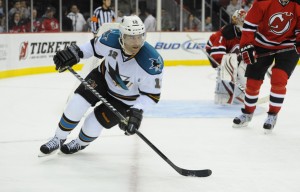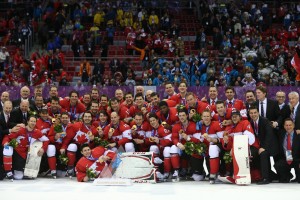Patrick Marleau, Always A Lightening Rod

San Jose Sharks forward Patrick Marleau is a highly skilled hockey player. He was selected for Team Canada and won his second Olympic gold medal just over a year ago. He’s been an iron man, playing in 76 or more games every full season since his rookie season (in the strike season, he played every game). He is on track to play all 82 games this year, making it likely that for the 12th time, he will finish a season having missed 2 or fewer games.
Marleau has also been a lightning rod for criticism over the years, most famously called out by former teammate Jeremy Roenick. Fairly or not, critics have gone almost everywhere with criticisms of Marleau. They range from failing to commit on defense to disappearing in the postseason, from not playing hard to to playing less far physically than he should.
Marleau is highly paid largely because he is a prolific goal scorer. He is 58th in NHL history and 3rd among active players behind only Marian Hossa and Alexander Ovechkin. He has 10 seasons with 25 or more goals and 7 seasons over 30 goals. However, his history is complicated by a plus/minus rating that belies an elite goal scorer playing on teams that have been highly successful over the years. Marleau has had 8 plus seasons, 8 minus seasons (including this one) and once finished exactly even. He is +12 for his 1300 game career, remarkably close to even over such a lengthy span.
See the Problem …
There is a different way to look at Marleau’s play, especially in recent years. He seems to be great at the start of the season, and not very good after that. The numbers tell the story. In the first 10 games of the season over the past 4 seasons, Marleau is an elite player. In those 40 games, Marleau has 23 goals, 23 assists and is +14. Normalized to reflect an 82 game season, that is 47 goals, 47 assists, 94 points and +29. Those are Hart Trophy finalist numbers.
Now look at what happens after game 10. In the last 4 seasons after game 10, Marleau has played in every game, 239 in all. He has totaled 72 goals and 95 assists. He is -21 in these games. Normalized to 82 games, it averages out to 25 goals, 33 assists and -7 per season.
The difference is substantial between the first ten games of the year and the remainder of the year. Normalized to 82 games, Marleau’s productivity rate drops by 22 goals, 10 assists and most shockingly, -36.
In essence, when the grind begins, Marleau’s play dips. This is not a surprise. He plays every game, plays extensive minutes and is 35 years old. Through 67 games this year, Marleau is 10th among NHL forwards in ice time and is the oldest forward among the top 30 in ice time. Among these top 30 forwards in ice time, only Marleau and Mike Ribeiro (25th in TOI) are over age 32. Unlike Ribeiro, Marleau is also tasked with the toughest minutes, those with the team shorthanded.

The prior season was just as telling. Marleau finished sixth among NHL forwards in regular season ice time. Add to that, he played the maximum 6 Olympic games. In terms of meaningful minutes played, Marleau led all forwards entering the playoff series versus the LA Kings. He was very effective in the early games of the series, where there had been substantial rest before and between games. As the series went on and games occurred every other day, his play diminished considerably. The trend began before the series last year. Take a look at how Marleau has performed late in playoff series once they pass game 4 in the last 4 postseasons. Since 2011, he has played in 13 of these late series games (series games 5, 6 and 7). Two goals, two assists and -7. Lesson learned? Apparently not.
To Fix the Problem
How extensive ice time impacts Marleau’s game is complex. Marleau likely understands how to save energy over the course of a season, so some effects may be counter intuitive. For example, he has just 1 first period goal all season, his other 14 goals split evenly over the final 2 periods. This might suggest a player managing his energy early in games in order to have something left for the remainder of the game. Marleau continues to show moments of brilliance, including a critical sequence as last week against Vancouver. It began with a sharp move to the net forcing the goalie into a very tough save, then moments later catching Daniel Sedin from behind, stripping him of the puck and firing a crisp tape pass to a teammate for a goal. The skills are there, the question is how often do they appear?
Only one other NHL coach (Nashville’s Peter Laviolette with Ribeiro) has seen fit to use a player Marleau’s age to nearly the extent Todd McLellan uses Marleau. McLellan does believe in riding his top players. Joe Pavelski is fifth among forwards in ice time, Logan Couture 20th. Joe Thornton, the same age as Marleau, would likely be around 30th, had he not missed 4 games due to injury. Thornton, Pavelski and Marleau were all top 30 in ice time among forwards the prior season as well. This is not new for McLellan. Former Sharks defenseman Dan Boyle was consistently among the league leaders in ice time well into his 30’s, including finishing 7th overall at age 35, no one else in the top 1o was over 32 that season.
It is hard to understand what McLellan has been thinking. Perhaps he can take a page from Gregg Popovich, head coach of the San Antonio Spurs. Popovich gets credited with keeping the playing time down for his older players, once earning a substantial fine from the league for giving too many of his players the same game off. But he knew what he was doing. Over a long season, what is clear to Popovich: less is more. For Popovich, ‘more’ recently included a fifth NBA championship. In the case of Patrick Marleau, what is clear, but not surprising: more is less.